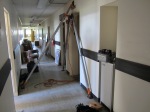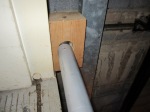Here are some new AZV uses we at R2T have been testing to see the real world practicality of. There are some earlier proof of concept pictures on the multimedia page, but these were done in exposure with a two person load. They’re all versions of what we’ve decided to call the Appalachian Doortex (APD), an obvious attempt at getting some East Coast love into the rope world.
The purpose of these APD is to create either an anchor, a high directional, or both simultaneously in the urban environment. The initial thought was for use in elevators, but can obviously work to create an anchor anywhere there is a solid block wall surrounding a door. We run A LOT of stalled elevators in in the city where I work, 15 a day is about average in our geographically small city. Not many require any rope work at all, but the one’s that do can be a real pain. Have you ever looked in an elevator lobby for anchors or a high directional? Not much around. That’s the problem we were trying to solve.
The “Ram’s Head” is the first version we came up with. In this configuration we hooked both MPDs right to the head of the APD; there was no guying, tying, or anything. The foot of the lazy leg was not resting against the opposite wall. Aside from a very minor initial settling in of the APD, it did not move during the operation. It was loaded with a two person load that was raised and lowered several times. One of the MPDs was hooked up in a fashion that caused it to bind against the head of the AZV a bit because it allowed us to have the operating handle facing outward. Because of the angle of the rope leaving the MPD into the elevator shaft, this very minor binding was felt not to be an issue.
Next up is an Upside Down APD, with no clever name given yet. Maybe the Appalachian Lean-To (ALT)? Yup we’ll go with that for now. Just another way to make an anchor/HD combo. Also loaded with a two person load, operated up and down a bunch.
Here is the close up of the dual MPD anchoring on the Appalachian Lean-To.
Below are two pictures of what we used to keep the the Appalachian Lean-To from kicking back should it have wanted to. It didn’t want to. We had a dynomometer in there to see if there was any force trying to push the ALT away from the opening. The needle didn’t move at all during the operation. We were pulling against an extra leg section of an AZV run through two 4×6 blocks with holes drilled in them to keep the leg section from resting on a small, roll prone contact point on the hoistway doors. We’ve been calling them “Brace Blocks” (Appalachian Brace Blocks?) They worked really well. I suspect they can be used to help span doorways in buildings to create quick, simple anchors in a hallway.
While we have not tested a center pulled AZV leg to failure yet, this one was pulled to 500 lbs without any visible deflection. Further testing on this configuration will be conducted in the near future and we’ll let you know what we find out.
If anybody has any thoughts, questions or comments on this, or would like further training on operating on rope in an urban environment please feel free to leave a comment below or send Kelly an email directly at rescue-2@comcast.net.







Hey Guys great Job with the “APD”. I understand how your lowering with the MPD in this configuration, but how are you converting to a raise, without having a crap loads of resets.
We did a crap load of resets! Next time we build this, we are going to have haul systems rigged down the hallways with opposing haul systems to have the two resultant forces on the COD’s cancel each other out.
Either that or have both lines going downthe hallway in the same direction and tie off the opposing side of the APD.
Thanks for speaking up!
I’ll look for that, Thanks
Hey Kelly,
Wondering if you had tried anything new as far as raising with the APD? We’ve tried a few things that seem to work so far. Tied both legs to strut that spans the opening. This seems to work the best so far. Looking at it from the side if there wasn’t anything to oppose the pull. The opposing pull tie back worked and everyone liked it. Trying to come up with something just in case we couldn’t find a way to tie the opposing side. We’ve also used a paratech 610 strut with is easily adjustable to most elevator and freight doors. Worse case we install an 435 extension which should cover any freight door. Trying to find a Dyna to get some feedback on forces. Still want to do some more testing on the raising before I put it out there. I’ll try to get you some picture, which might make a bit more sense. If you have any other info I would love to see what you have. I love the Vortex and I dont think it gets used enough. Mainly because people aren’t thinking outside the box.
Thanks Again
Sandy Lasa
Boston Fire
Rescue 1
Pictures would be awesome. I’m pretty sure I’m tracking, but a picture would make it 100% in my head.
One thing that we have recently been messing around with, to really good success, is this: With the MPD still on the head of the AZV after the lower, you can lower a bight of slack rope down to the rescuer, who can run it through a pulley attached to himself.
It might sound confusing, but you are essentially creating a 3:1 block and tackle attached to the load. The MPD is the progress capture. The benefit of this system is that you are guaranteed not to need a reset. The downside is that you need 3 times the amount of rope. If you have to lower a rescuer 50 feet, you need 150 to accomplish the raise.
A variation of this that I have been thinking about, but have not tried yet, is to make a standard 3:1 with a Gibbs type rope grab that has a pull cord attached to it so the rescuer can pull the Gibbs down towards him to get a longer reset on the system. Kind of like pulling a block and tackle rigged off of a tripod back down into a confined space hole.
Thanks for taking the time to post!
Very cool and most importantly very informative. Where in NY do you work?
Also, do you guys run the Petzl I’D. I could see it working in this configuration as long as you’d throw in a few pulleys in the mix.
Petzl i’Ds would work too; the MPDs are just so sweet to work with on a haul because they have so much less friction than an i’D. Another easy way to work this if you don’t have an MPD is to hook a block and tackle to the head of the APD. Limited throw and a couple of moving lines over the edge, but it’s easy.
Also, I work at Rescue 2 in Wash. DC.
Thanks for looking and commenting!